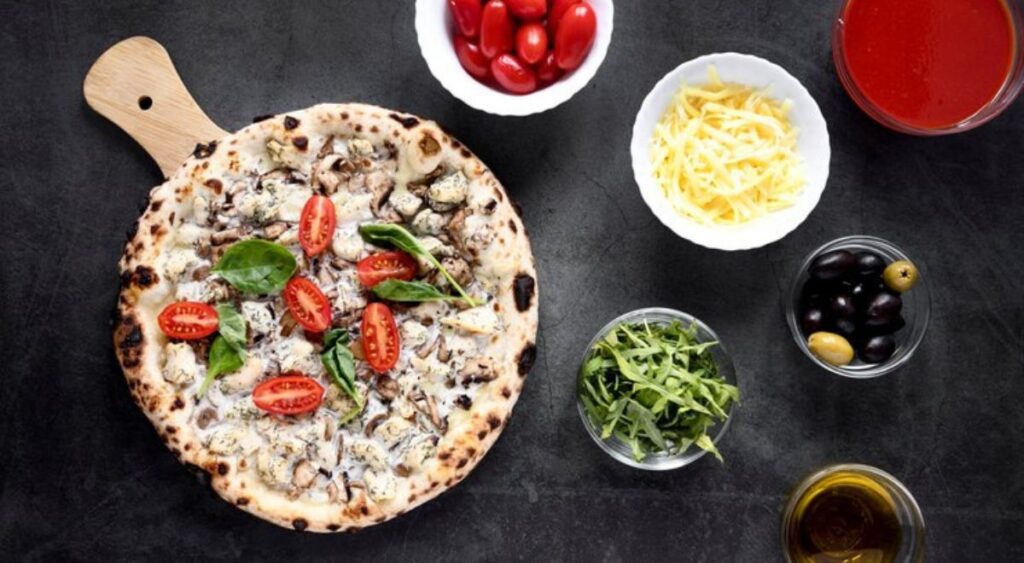Low Sodium Pizza Recipe in 2024: A Heart-Healthy Alternative
Pizza is one of the most beloved foods worldwide, but it’s often packed with high levels of sodium, making it less ideal for those watching their salt intake. Fortunately, with a few simple adjustments, you can enjoy a delicious, homemade low-sodium pizza that satisfies your cravings without compromising your health. This article will guide you through a step-by-step process to create a tasty low-sodium pizza at home, perfect for anyone looking to reduce their sodium intake while still enjoying this classic dish.

Table of Contents
Why Choose a Low-Sodium Pizza?
Before we dive into the recipe, let’s explore why low-sodium options are essential, especially in popular dishes like pizza. High sodium intake has been linked to various health issues, including hypertension, heart disease, and stroke. The average pizza can contain up to 1,000 milligrams of sodium per slice, which can quickly add up. By making a few smart choices, you can significantly reduce the sodium content in your pizza, making it a healthier option for you and your family.
Ingredients for Low-Sodium Pizza
Creating a low-sodium pizza involves choosing ingredients that naturally contain less sodium and making some homemade components. Here’s what you’ll need:
For the Pizza Dough:
- 2 cups all-purpose flour (or whole wheat flour for a healthier option)
- 1 packet of instant yeast (or 2 1/4 teaspoons)
- 1/2 teaspoon salt (optional or use a low-sodium alternative)
- 1 tablespoon olive oil
- 3/4 cup warm water

For the Tomato Sauce:
- 1 can (14.5 oz) no-salt-added tomato sauce
- 1 tablespoon tomato paste (optional for thicker sauce)
- 1 teaspoon dried oregano
- 1 teaspoon dried basil
- 1/2 teaspoon garlic powder
- 1/2 teaspoon onion powder
- 1/4 teaspoon black pepper
- 1/2 teaspoon sugar (optional, to balance acidity)
For the Toppings:
- 2 cups shredded low-sodium mozzarella cheese (or part-skim mozzarella)
- 1/2 cup sliced bell peppers
- 1/2 cup sliced mushrooms
- 1/2 cup sliced onions
- 1/2 cup spinach leaves
- 1/4 cup thinly sliced tomatoes
- Fresh basil leaves (optional)
- Other toppings of your choice (ensure they are low-sodium)
Step-by-Step Instructions
Step 1: Prepare the Pizza Dough
- Activate the Yeast: In a small bowl, combine the warm water and yeast. Let it sit for about 5 minutes until it becomes frothy.
- Mix the Dough: In a large mixing bowl, combine the flour and salt. Create a well in the center and pour in the yeast mixture and olive oil. Stir until a dough forms.
- Knead the Dough: Transfer the dough onto a lightly floured surface and knead for about 5-7 minutes until smooth and elastic. If the dough is too sticky, add a little more flour.
- Let the Dough Rise: Place the dough in a lightly oiled bowl, cover it with a damp cloth, and let it rise in a warm place for about 1 hour, or until it doubles in size.
Step 2: Prepare the Tomato Sauce
- Combine Ingredients: In a medium saucepan, combine the no-salt-added tomato sauce, tomato paste (if using), oregano, basil, garlic powder, onion powder, black pepper, and sugar (if using).
- Cook the Sauce: Simmer the sauce over medium heat for about 10-15 minutes, stirring occasionally, until it thickens slightly. Taste and adjust the seasonings as needed.
Step 3: Assemble the Pizza
- Preheat the Oven: Preheat your oven to 475°F (245°C). If you have a pizza stone, place it in the oven while it preheats.
- Roll Out the Dough: On a lightly floured surface, roll out the dough to your desired thickness. Transfer the rolled dough to a pizza peel or baking sheet lined with parchment paper.
- Add the Sauce: Spread a thin layer of your prepared tomato sauce over the dough, leaving a small border around the edges.
- Add the Cheese: Sprinkle the shredded low-sodium mozzarella cheese evenly over the sauce.
- Add the Toppings: Arrange your selected vegetables and other toppings over the cheese. Be creative with your topping choices, but remember to keep them low in sodium.
Step 4: Bake the Pizza
- Bake the Pizza: Transfer the pizza to the preheated oven. If using a pizza stone, carefully slide the pizza onto the stone. Bake for 10-12 minutes, or until the crust is golden and the cheese is melted and bubbly.
- Cool and Serve: Remove the pizza from the oven and let it cool for a few minutes before slicing. Garnish with fresh basil leaves if desired, and enjoy your homemade low-sodium pizza!

Nutrient Table: Low-Sodium Pizza Per Slice (Based on an 8-Slice Pizza)
| Nutrient | Amount per Slice |
|---|---|
| Calories | 180 kcal |
| Total Fat | 6g |
| Saturated Fat | 2g |
| Cholesterol | 15mg |
| Sodium | 140mg |
| Total Carbohydrates | 24g |
| Dietary Fiber | 2g |
| Sugars | 2g |
| Protein | 8g |
| Vitamin A | 8% DV |
| Vitamin C | 10% DV |
| Calcium | 15% DV |
| Iron | 10% DV |
Tips for Making the Perfect Low-Sodium Pizza
To enhance your low-sodium pizza experience, consider the following tips:
1. Choose the Right Cheese
Cheese is one of the main contributors to sodium in pizza. Opt for low-sodium mozzarella or make your own cheese at home to control the salt content. You can also experiment with other low-sodium cheese varieties like ricotta or goat cheese.
2. Load Up on Vegetables
Vegetables not only add flavor and texture to your pizza but also contribute essential nutrients without adding much sodium. Fresh vegetables like bell peppers, onions, mushrooms, spinach, and tomatoes are excellent choices. You can also experiment with other low-sodium vegetables like zucchini or eggplant.
3. Be Mindful of Meats
Traditional pizza meats like pepperoni and sausage are high in sodium. If you prefer meat on your pizza, consider using low-sodium chicken breast or turkey. You can also experiment with plant-based meat alternatives that are lower in sodium.
4. Use Herbs and Spices
Herbs and spices can significantly enhance the flavor of your pizza without adding sodium. Fresh basil, oregano, thyme, and garlic are excellent choices. You can also experiment with crushed red pepper flakes for a bit of heat.
5. Make Your Own Dough and Sauce
Store-bought pizza dough and sauce often contain added sodium. By making your own dough and sauce at home, you have complete control over the ingredients and can significantly reduce the sodium content.
6. Opt for Whole Wheat or Cauliflower Crust
For a healthier and more nutritious pizza, consider using whole wheat flour or a cauliflower crust. These options are higher in fiber and other nutrients compared to regular all-purpose flour. Plus, they add a unique flavor and texture to your pizza.
FAQs
Is Homemade Pizza High in Sodium?
Homemade pizza can be lower in sodium compared to store-bought or restaurant pizzas, especially if you control the ingredients. By using low-sodium tomato sauce, fresh vegetables, and low-sodium cheese, you can significantly reduce the sodium content. However, it depends on the specific ingredients you choose, so homemade pizza can vary in sodium levels.
What Pizza Has the Most Sodium?
Pizza with processed meats like pepperoni, sausage, or bacon typically has the most sodium. Pizzas from fast-food chains or frozen varieties are often high in sodium due to the added preservatives, sauces, and cheeses. Specialty pizzas with multiple toppings can also be high in sodium, sometimes exceeding the daily recommended intake in just a few slices.
Conclusion
Making a low-sodium pizza at home is not only possible but also delicious and rewarding. With a few simple adjustments, you can enjoy your favorite pizza while keeping your sodium intake in check. Whether you’re managing high blood pressure, heart disease, or just looking to eat healthier, this low-sodium pizza recipe is a fantastic option. Packed with fresh vegetables, a flavorful homemade sauce, and low-sodium cheese, this pizza is proof that healthy eating doesn’t have to mean sacrificing taste.
So, the next time you’re craving pizza, skip the takeout and try making this heart-healthy, low-sodium version at home. Your taste buds and your heart will thank you!